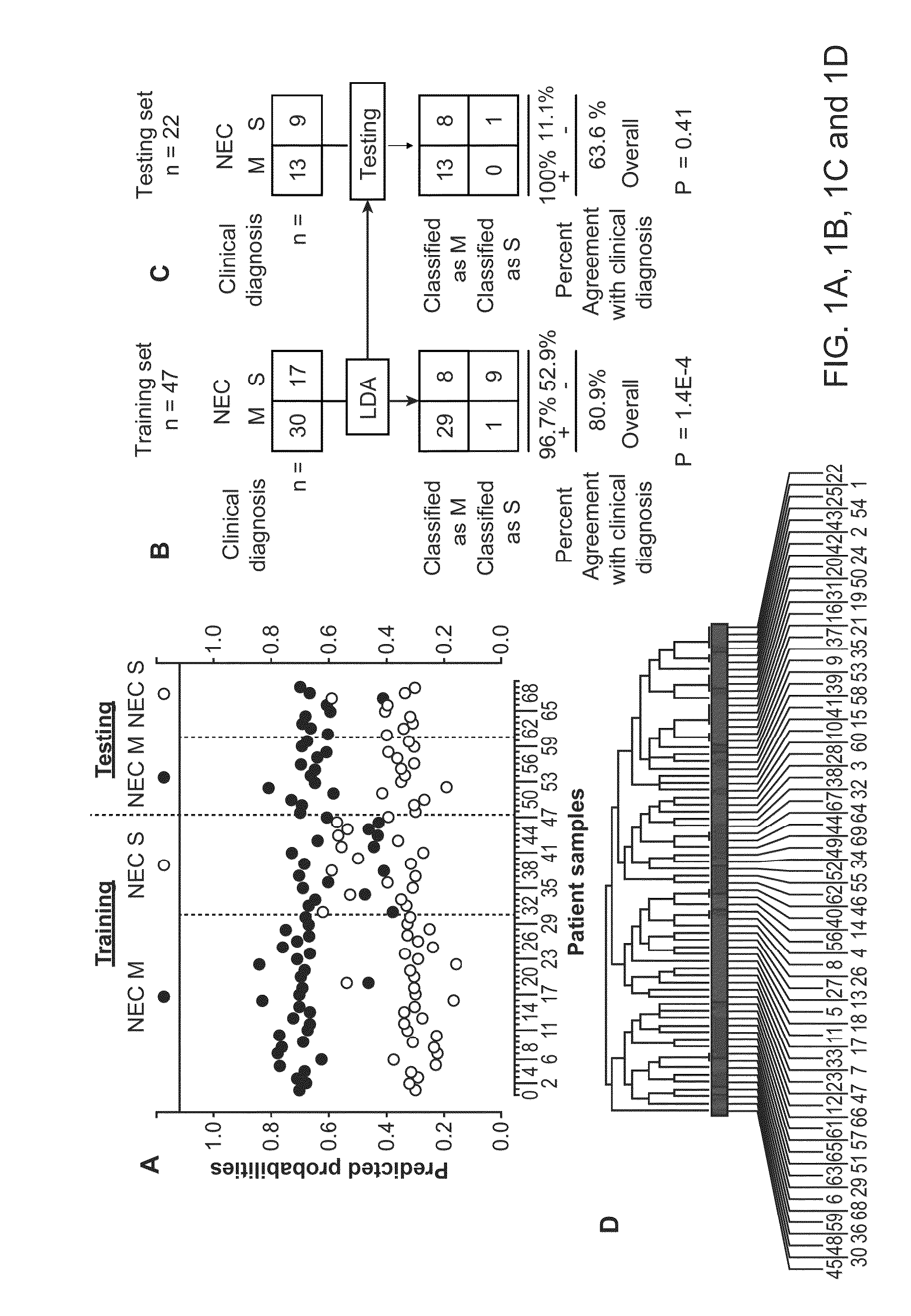Urine biomarkers for necrotizing enterocolitis and sepsis
a technology of enterocolitis and sepsis, which is applied in the field of urine biomarkers for necrotizing enterocolitis and sepsis, can solve the problems that laboratory tests and diagnostic imaging fail to capture the nuanced differences between these entities during their onset and progression, and achieve the effect of predicting the responsiveness of a patien
- Summary
- Abstract
- Description
- Claims
- Application Information
AI Technical Summary
Benefits of technology
Problems solved by technology
Method used
Image
Examples
example 1
[0138]Necrotizing enterocolitis (NEC) is a major cause of overall neonatal morbidity and mortality. Disease outcome for infants with NEC is largely determined by the degree of clinical progression. Generally, half of affected infants recover with medical therapy alone (NEC M=medical class) and 30-50% develop progressive disease requiring surgery or resulting in death (NEC S=surgical class). Most of the disease associated morbidity, and nearly all of the mortality, occurs in the cohort with progressive disease requiring surgery. Previous attempts to identify clinical parameters that could reliably identify infants with NEC most likely to progress to severe disease have been unsuccessful. We hypothesized that an integrative analysis of clinical parameters along with protein biomarkers would result in a predictive algorithm of NEC progression. A multivariate analysis of patients (NEC 43 M and 26 S) using the standard NEC classification scheme of Bell failed to differentiate NEC outcome...
example 2
Methods
[0187]Patient Population.
[0188]This study was approved by the human subjects' protection programme at each participating institution (Stanford protocol ID 23091). Informed consent was obtained from the parents of all enrolled subjects. Patient contributions by institution included: Baylor / Texas Children's Hospital (n=184), Yale-New Haven Children's Hospital (n=158), UCSF / Benioff Children's Hospital (n=79), Boston Children's Hospital (n=75), UCLA / Mattel Children's Hospital (n=42), Johns Hopkins Children's Center (n=22), Stanford / Lucile Packard Children's Hospital (n=16) and Children's Hospital of Philadelphia (n=11). Complete data collection including patient-specific demographic, clinical and laboratory data were prospectively collected from a total of 550 infants. Those with incomplete data collection were excluded from the study.
[0189]Urine samples were collected from a subset of 65 infants with suspected NEC. Patient contributions by institution included: Baylor / Texas Chil...
example 3
[0218]Necrotizing enterocolitis (NEC) is an inflammatory condition of the neonatal gastrointestinal (GI) tract most strongly associated with prematurity and the initiation of enteral feeding. The underlying etiology remains poorly understood, but is thought to be multifactorial, involving factors inherent to the premature neonate and its environment. Specific features believed to be involved in the development of NEC include an underdeveloped GI mucosal barrier, immature innate and humoral immunity, uncoordinated intestinal peristalsis, and pathogenic bacterial overgrowth (Lin et al., Necrotizing enterocolitis: recent scientific advances in pathophysiology and prevention. Seminars in perinatology. 2008; 32:70-82). Despite many advances in neonatal intensive care, NEC continues to be a major source of morbidity and mortality in preterm infants. It is diagnosed in 1% to 5% of all neonatal intensive care unit (NICU) patients with an incidence of up to 15% in infants weighing less than ...
PUM
 Login to View More
Login to View More Abstract
Description
Claims
Application Information
 Login to View More
Login to View More - R&D
- Intellectual Property
- Life Sciences
- Materials
- Tech Scout
- Unparalleled Data Quality
- Higher Quality Content
- 60% Fewer Hallucinations
Browse by: Latest US Patents, China's latest patents, Technical Efficacy Thesaurus, Application Domain, Technology Topic, Popular Technical Reports.
© 2025 PatSnap. All rights reserved.Legal|Privacy policy|Modern Slavery Act Transparency Statement|Sitemap|About US| Contact US: help@patsnap.com



